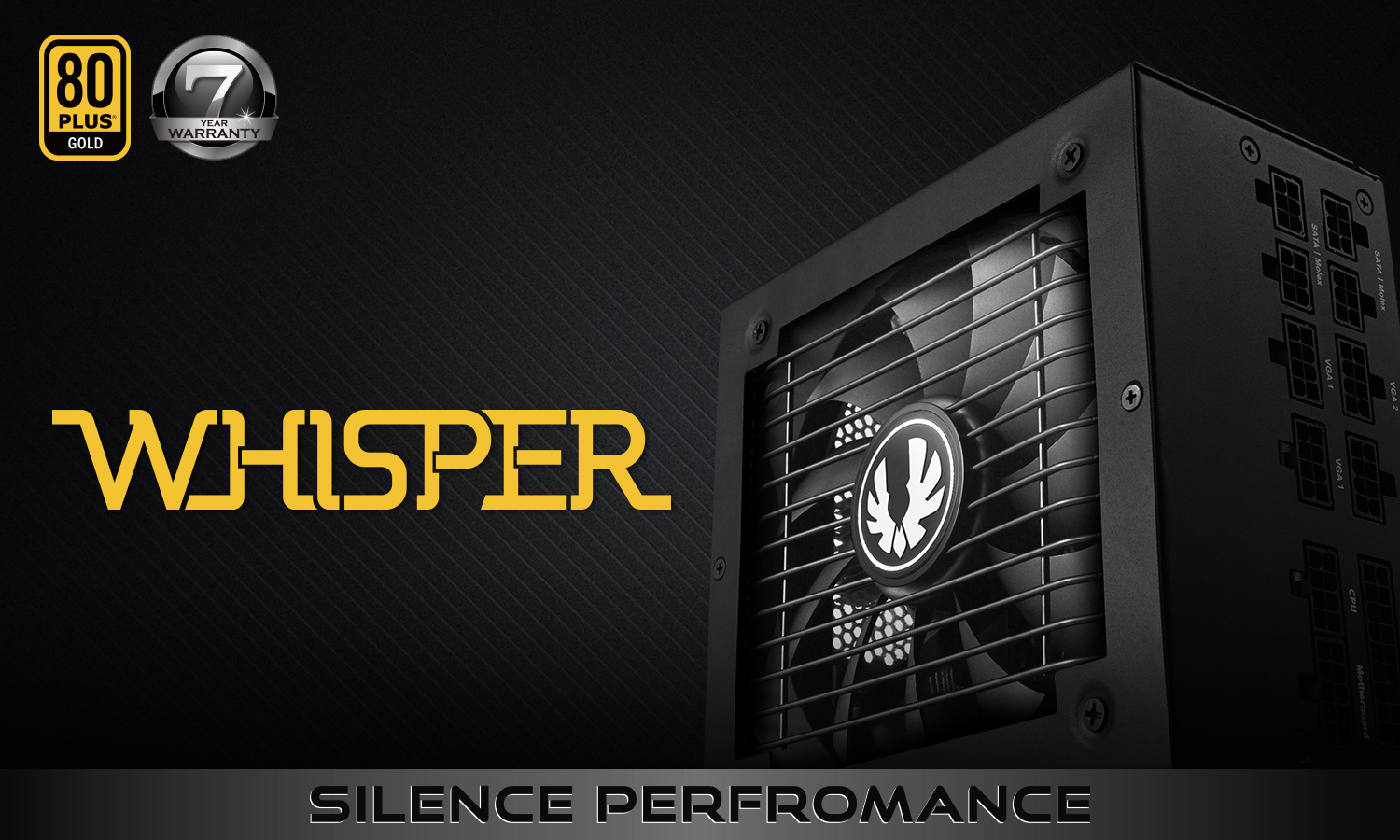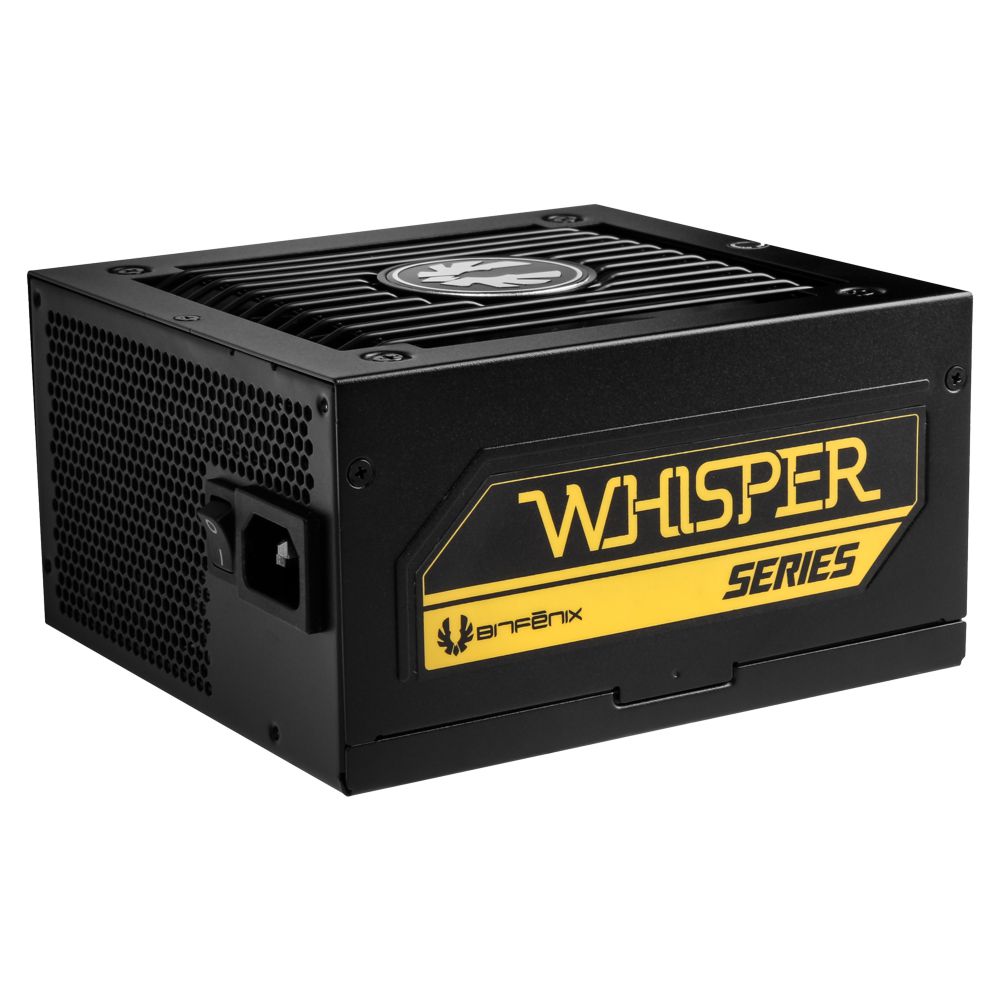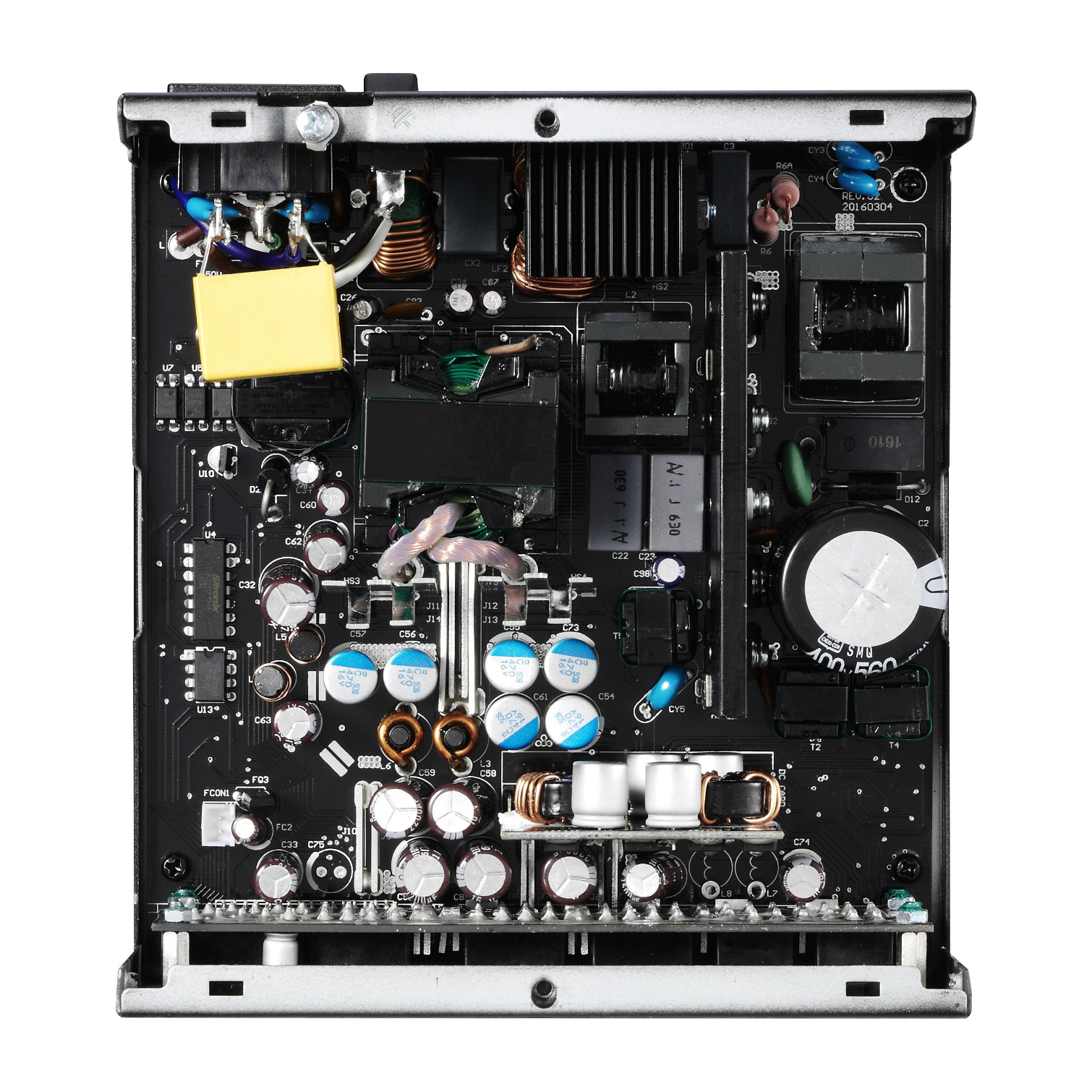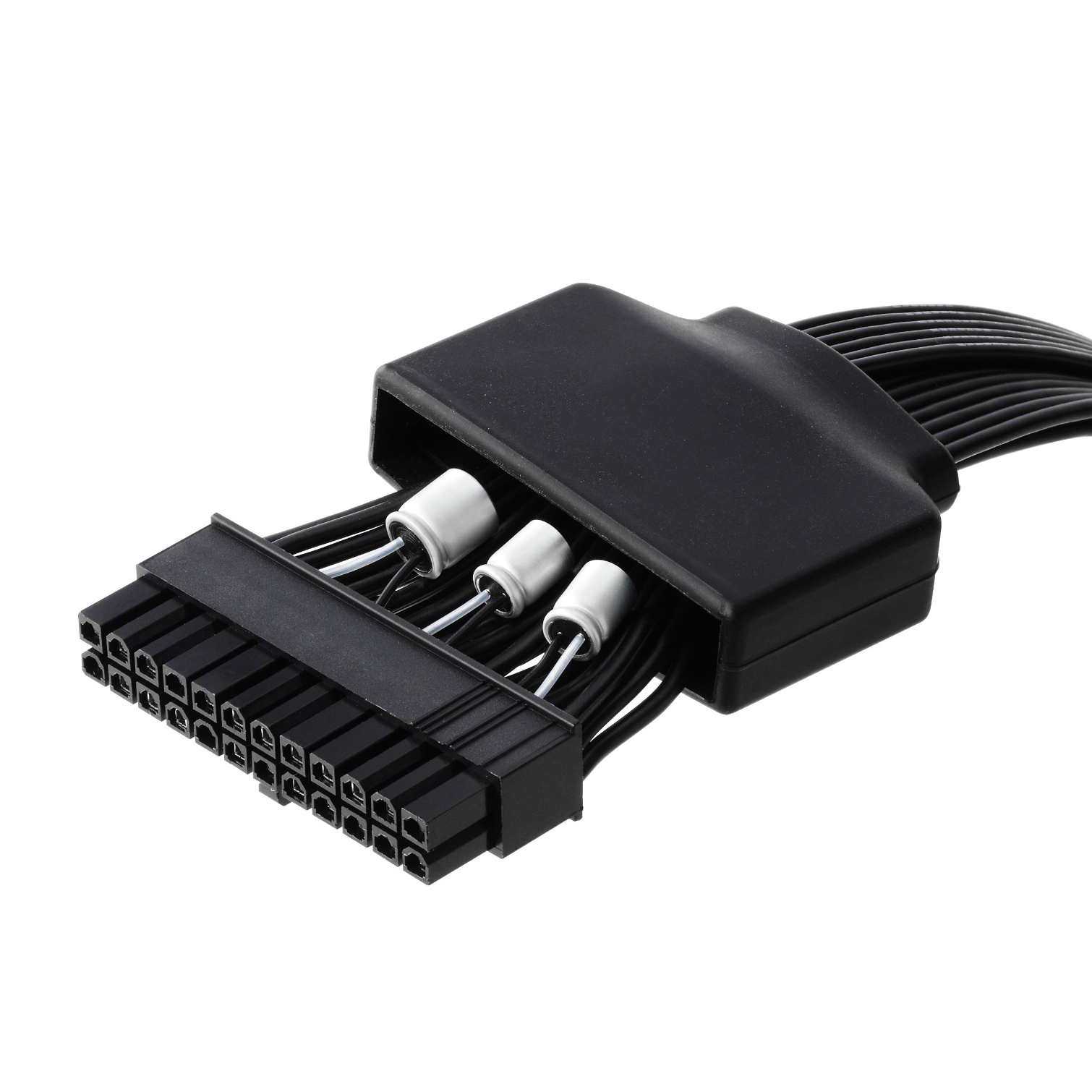Bitfenix Unveils The Whisper PSU Line
Bitfenix, a company well known for its quality chassis, released its second PSU line which is called "Whisper." The Whisper units address users in need of silent, reliable, efficient, and fairly low-priced PSUs.
Bitfenix enrolled in the PSU market a couple of years ago with the Fury Gold units, which had a nice looks and featured quality, individually-sleeved cables but cost a lot, and their FSP platform didn't offer high enough performance. It seems that Bitfenix hasn't forgotten about the PSU market, though, and is looking to make a strong comeback with the Whisper line, which is made by a different OEM now--Channel Well Technology (CWT).
The members of this line cover a wide wattage range, from 450W to 850W, with 100W increments. All are fully modular and 80 PLUS Gold certified, while their CWT platform with code name "GPU" promises high performance, increased reliability, and silent operation. After all, the Whisper units have to honor their name. so they cannot be noisy under any usage scenario.
The two entry-level models of the line with 450W and 550W capacities have three +12V rails, whereas the 650W, 750W, and 850W Whisper units feature four +12V rails. At their internals, you'll find Japanese capacitors and an HDB fan, provided by Martech, which is rated for a pretty low lifetime of only 30,000h at 25°C. Bitfenix covers the Whisper units with a long seven-year warranty, so it's highly confident about the longevity of both the fan and the platform. Further, all necessary protection features are supported, including OTP (Over Temperature Protection).
The "GPU" platform is new, and the Whisper units are the first ones to use it. Bitfenix made some minor modifications to this platform, including a set of custom heatsinks for the +12V FETs, which won't be available to other companies that will be interested in using this CWT platform as well. In order to keep the production cost low, Bitfenix didn't equip the Whisper units with special modular cables, like it did with the Fury Gold line. However, you can purchase Bitfenix's Alchemy 2.0 cable kit, featuring the highly desired (by case modders, mostly) individually sleeved cables. We should mention here that only the 24-pin ATX connector uses three polymer caps for providing an extra ripple filtering layer, while all the rest cables don't have any caps attached.
If you plan to power a high-end mainboard that needs more than a single EPS connector, then the two stronger Whisper units are the ones to go after, because they come with a couple of 4+4 pin EPS connectors. All the lower-capacity models of this line are equipped with only a single EPS connector.
| Line | Whisper |
|---|---|
| OEM | Channel Well Technology |
| Platform | GPU |
| Models | BWG450M, BWG550M, BWG650M, BWG750M, BWG850M |
| DC Output Range | 450W - 850W |
| PFC | Active PFC |
| Efficiency | 80 Plus Gold |
| Modular | Yes (fully) |
| Intel Haswell Ready | Yes |
| Operating temperature | 0°C ~ 50°C |
| Protections | Over Voltage Protection Under Voltage Protection Over Current Protection Short Circuit Protection Over Power Protection Over Temperature Protection |
| Cooling | 135 mm Hydro Dynamic Bearing Fan (DF1352512SEMN or DF1352512SEHN) |
| Semi-passive operation | No |
| Number of PCIe (6+2 pin) Connectors | BWG850M, BWG750M: 6 BWG650M: 4 BWG550M, BWG450M: 2 |
| Number of EPS Connectors | BWG850M, BWG750M: 2 BWG650M, BWG550M, BWG450M: 1 |
| Dimensions | 150 mm (W) x 86 mm (H) x 160 mm (D) |
| Compliance | ATX12V v2.4, EPS 2.92 |
| Warranty | 7 years |
| MSRP | BWG850M: $119 BWG750M: $109 BWG650M: $89 BWG550M: $79 BWG450M: $69 |
We have already evaluated two members of this line, and the results were good. Given the fairly affordable MSRPs that Bitfenix set for these units, their performance per dollar ratios hit really high levels, making them ideal for users that are after good deals. The MSRPs are provided in the table above.
The following tables show the power specifications of all Whisper units.
Get Tom's Hardware's best news and in-depth reviews, straight to your inbox.
| BWG450M Power Specs | ||||||||
|---|---|---|---|---|---|---|---|---|
| Rail | 3.3V | 5V | 12V1 | 12V2 | 12V3 | 5VSB | -12V | |
| Max. Power | Amps | 20 | 20 | 25 | 25 | 25 | 2.5 | 0.3 |
| Watts | 100 | 450 | 12.5 | 3.6 | ||||
| Total Max. Power (W) | 450 |
| BWG550M Power Specs | ||||||||
|---|---|---|---|---|---|---|---|---|
| Rail | 3.3V | 5V | 12V1 | 12V2 | 12V3 | 5VSB | -12V | |
| Max. Power | Amps | 20 | 20 | 25 | 25 | 30 | 2.5 | 0.3 |
| Watts | 100 | 550 | 12.5 | 3.6 | ||||
| Total Max. Power (W) | 550 |
| BWG650M Power Specs | |||||||||
|---|---|---|---|---|---|---|---|---|---|
| Rail | 3.3V | 5V | 12V1 | 12V2 | 12V3 | 12V4 | 5VSB | -12V | |
| Max. Power | Amps | 20 | 20 | 25 | 25 | 30 | 30 | 2.5 | 0.3 |
| Watts | 100 | 650 | 12.5 | 3.6 | |||||
| Total Max. Power (W) | 650 |
| BWG750M Power Specs | |||||||||
|---|---|---|---|---|---|---|---|---|---|
| Rail | 3.3V | 5V | 12V1 | 12V2 | 12V3 | 12V4 | 5VSB | -12V | |
| Max. Power | Amps | 22 | 22 | 25 | 25 | 35 | 35 | 2.5 | 0.5 |
| Watts | 120 | 750 | 12.5 | 6 | |||||
| Total Max. Power (W) | 750 |
| BWG850M Power Specs | |||||||||
|---|---|---|---|---|---|---|---|---|---|
| Rail | 3.3V | 5V | 12V1 | 12V2 | 12V3 | 12V4 | 5VSB | -12V | |
| Max. Power | Amps | 22 | 22 | 25 | 25 | 40 | 40 | 2.5 | 0.5 |
| Watts | 120 | 850 | 12.5 | 6 | |||||
| Total Max. Power (W) | 850 |
As we already stated, the lower capacity units have three +12V rails, whereas the 650W, 750W, and 850W Whisper members feature four of them. Besides the capacity of the minor rails, there is also a small difference in the capacity of the -12V rail--a useless rail for modern PC systems, which is a little stronger in the top two Whisper models. Finally, in our opinion, the 5VSB rail should be a little stronger in the higher-capacity Whisper units and not be confined at 2.5A max current output.
Expect the new Bitfenix Whisper PSUs to be available on the U.S. market in a few days from now, on December 5.

Aris Mpitziopoulos is a contributing editor at Tom's Hardware, covering PSUs.
-
Vatharian Four 12V rails? Thank you, I'll pass. I'll get it, times when cross-loading lines would blow up fuses is gone (I had PSU that needed 100W resistors on unused 12V rails or else would shut down at 8A difference), but come on, that's wasting power!Reply -
turkey3_scratch Reply18913934 said:Four 12V rails? Thank you, I'll pass. I'll get it, times when cross-loading lines would blow up fuses is gone (I had PSU that needed 100W resistors on unused 12V rails or else would shut down at 8A difference), but come on, that's wasting power!
I think you have some misconceptions of how multi-rail PSUs work. -
Mod by San more likely that you had a faulty PSU -_- or did you purchase it in like stone age?Reply -
Vatharian I understand them perfectly, I was making a comment in view of history of PSUs, when regulations forced max 20 A per rail, resulting in 6-rail 1200W monsters.Reply
Multi-rail PSUs have advantage of isolating devices from each other (so you can run noisy fans/pump and delicate soundcard or some exotic interface that requires stable ripple-free power source from one PSU, but the cost is you have to carefully balance current on different rails, and if you don't have right number of devices, you'll end up wasting power - you won't be able to use full current capacity of power supply. Efficiency will also suffer, since it's unlikely you'll be able to balance the rails for that sweet 75%. Single-rail has advantage of giving you always your max current capacity regardless of number of connected devices, at the cost of small crosstalk, but they are usually much higher quality. Some PSUs use multiple bridged rails, which is possibly worst choice - you have (usually) lower quality components, you have crosstalk, and small imperfections will create current flow between regulating circuitry of each rail, that will hurt service time and efficiency. -
turkey3_scratch Reply18915649 said:I understand them perfectly, I was making a comment in view of history of PSUs, when regulations forced max 20 A per rail, resulting in 6-rail 1200W monsters.
Multi-rail PSUs have advantage of isolating devices from each other (so you can run noisy fans/pump and delicate soundcard or some exotic interface that requires stable ripple-free power source from one PSU, but the cost is you have to carefully balance current on different rails, and if you don't have right number of devices, you'll end up wasting power - you won't be able to use full current capacity of power supply. Efficiency will also suffer, since it's unlikely you'll be able to balance the rails for that sweet 75%. Single-rail has advantage of giving you always your max current capacity regardless of number of connected devices, at the cost of small crosstalk, but they are usually much higher quality. Some PSUs use multiple bridged rails, which is possibly worst choice - you have (usually) lower quality components, you have crosstalk, and small imperfections will create current flow between regulating circuitry of each rail, that will hurt service time and efficiency.
No no no no. A multi-rail unit can easily be turned into a single-rail unit just by shorting the shunts that go to the protection IC. The protection IC is the only thing that differs, what wires are linked to what overcurrent protections; overcurrent protections which kick in far after the rated amperage of said rail. You don't need to do any manual distribution, what cables go to what protections are already built into the design.
It has no effect on efficiency. All the wires from these "rails" all come from the same source, the same 12V rectifiers, they're filtered by the same capacitors. Just some of those wires are separated into their own little protections so in the situation of an overload from a short that SCP does not detect the unit will shut off before you have melted wire at the bottom of your case.
Multi-rail costs more money to implement than single-rail (and stuff that's worse never costs more money). This is because multi-rail is safer, there is no denying that. But of course the some companies chose a better route: use the cheaper, less-safe single rail and turn it into a marketing point. Now we have XFX's "Easy Rail Plus" or some crap like that. And the American market bought this stuff like crazy, so much that spending more money for multirail is almost pointless since 90% of people do not realize it's a safety measure and nobody will buy their multi-rail power supplies based on false myths from sly marketing gimmicks. -
NightLight what does alarm me, is the poor solder quality shown in the picture. If you look at the blue tantalum in the right upper corner, there's almost no solder between the top pin and the board. Same for numerous points I can see.Reply -
emgarf If they can't even spell "performance" correctly, they can't be trusted to design electronics.Reply -
memadmax Looks like a decent build. If there were caps on the lines that go to the GPU card(s) not just the main one going to the mobo then I would be more interested in this box.Reply -
therealduckofdeath @Nightlight, if you zoom in (a lot) you notice it's a visual illusion making it look like there is no soldering.Reply



